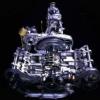Стоп
у импрезы sti свои ньюансы
есть Active AWD, есть VTD AWD, на STI можно увидеть и DCCD
и механика таки от автомата отличается по части "полноты" привода
вот раскопал статью
http://www.subaruwor...u_repair_19.htm
выходит честный полный - только у РКПП ! Вот как... а сосед мой думал что и у него  пока не зарылся элементарно во дворе многоэтажки
пока не зарылся элементарно во дворе многоэтажки
кстати, выходит совсем наоброт если читать тот линк - при разгоне смещается к 50/50 
блин... чето мудрено выходит...
просто я объясню - хочется так сказать отделить котлет от мух... если реальная субару - только STI, то я пойму.. но говорить допустим об Outback что у нее смещенный вниз центр тяжести (при клиренсе 20см!) - я как то невольно улыбаюсь, т.к. у меня на астре он по сути ниже... но это же не делает мою машину лучше!
Вот верю что в целом субару рулится = ездил, знаю. Но внедорожные качества не испытывал, а сведения о них неоднозначны.
у мну автомат. при старте гребут все четыре одновременно, а не после пробуксовки одной из осей. постоянный полный привод.
вот варианты у моделей 2008го года:
http://www.premier22...specifications/РКПП: Централизованная дифференциальная передача в сочетании с вязкостным LSD
АКПП: Система полного привода с активным разделением крутящего момента
кстати, и по твоей ссылке в отношении автомата говорится: В данной схеме
полный привод действительно постоянный, с несимметричным межосевым дифференциалом (45:55), блокирующимся гидромеханической муфтой с электронным управлением.
АКПП: Система полного привода с активным разделением крутящего момента (
Active Torque Split AWD)
Active all-wheel drive is a term coined by Subaru to differentiate the all-wheel drive system in the automatic transmission from other "reactive" all-wheel drive systems on the market today. What makes this all-wheel drive system so special is
its ability to anticipate traction needs and act before a wheel slips.The mechanism that transfers torque fore and aft is contained within the transmission’s tailshaft. To the casual observer it looks just like a typical hydraulic clutch found in any automatic. The key difference in this clutch pack is its operation. It’s designed to slip according to how much all-wheel drive is needed. When an automatic’s clutch slips, it is due to a malfunction and will eventually burn up. But the multi-plate transfer (MPT) clutch uses a special friction material that easily withstands the friction loads generated during torque transfer.
The MPT’s operation is controlled by the Transmission Control Unit (or TCU) and constantly changes dependent on how the vehicle is being driven. To get more all-wheel drive, the TCU increases the hydraulic pressure to the clutch for less slippage. Less all-wheel drive calls for more slip and the TCU reduces the hydraulic pressure to the clutch.
Under normal, dry pavement operation torque split is about
90% front and 10% rear. This distribution helps to compensate for the car’s weight distribution and resultant smaller effective rolling diameter of the front tires. As weight transfers to the rear of the vehicle, (i.e., under acceleration), the TCU shifts the torque split more toward the rear wheels. Under hard braking, torque is directed forward.
Torque distribution is changed based upon how the vehicle is being driven. Throttle position, gearshift lever position, current gear and other factors combine to influence the TCU and it, in turn, selects a software map that determines how aggressively torque split will be adjusted.Two speed sensors are used by the TCU to detect wheel slippage. One sensor monitors the front axle set, the other the rear axle set. Pre-programmed variables help the TCU differentiate between slipping wheels and normal wheel speed differentials as what occurs when cornering. A speed differential (front-to-rear) of up to 20% signals the TCU that the vehicle is cornering and torque is distributed to the front wheels to help increase traction during the turn. Anything above 20%, however, indicates to the TCU that wheel slippage is occurring and torque is then distributed to the rear wheels.
Another feature of the all-wheel drive system is its interaction with the anti-lock brake system. When ABS is engaged, the transmission selects third gear, reducing the unpredictability of engine braking and, thus, reducing the possibility of wheel lock-up. But all four wheels are still connected to the engine through the AWD system and are brought back up to overall vehicle speed quicker and can, therefore, be controlled again sooner. In a two-wheel drive system if the locking wheel isn’t a drive wheel, it can only be brought back up to overall wheel speed by whatever traction exists between it and the road. The quicker a wheel is controlled the better the stopping performance
===================
ну типа по умолчанию перед/зад 90%/10%, но при езде/ускорении, чем больше веса припадает на заднюю ось, тем больше крутящего момента на нее передается.
на наших форумах тоже встречал мнения, что у Легаси с АКПП более совершенный полный привод чем с МКПП
Изменено: Manager, 05 Февраль 2010 - 23:09
Не верю!!! (С)















